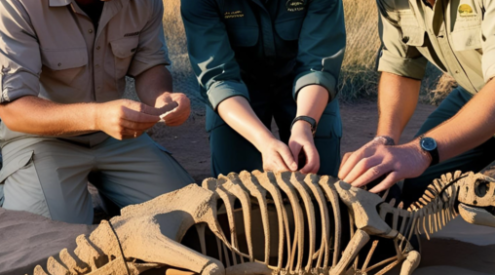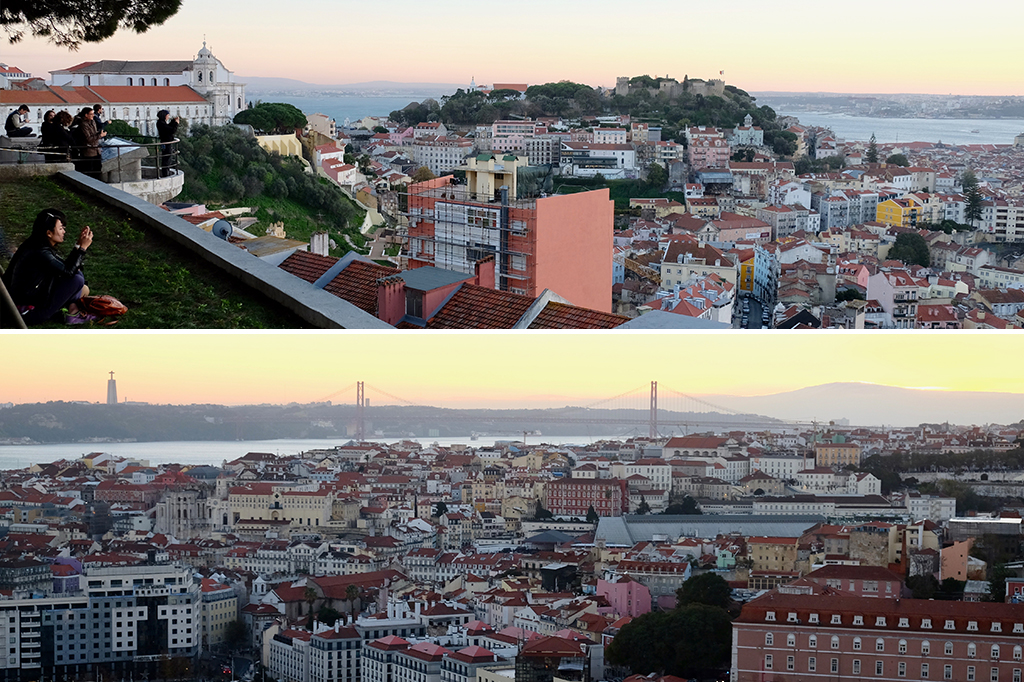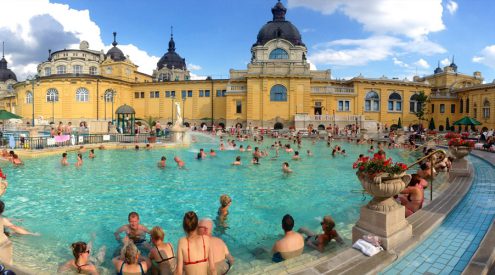Lisbon is famed for its long sunny afternoons, developing foodie scene, and beautiful beaches – and it’s one of the most affordable cities in Europe, which makes it a hotspot for South Africans. Here’s my pick of the best ways to stretch your rands – from the best time of year to visit, to the most affordable day trips from Lisbon.
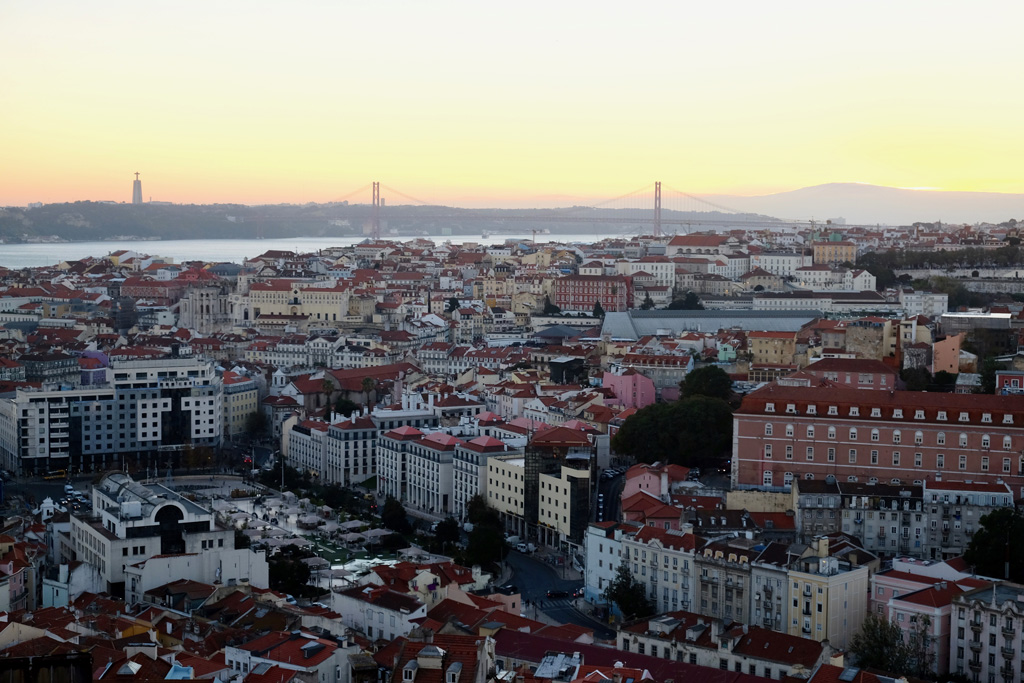
Looking over Lisbon towards the 25 de Abril Bridge.
A special feeling descends on the Portuguese capital at twilight. The skies above the orange roofs of the historic centre turn a chalky shade of pink; in the distance the 25 de Abril Bridge sparkles after a day of statuesque suspension across the mighty Tagus River; and, for a brief moment, the streets grow hushed, as if the city is drawing in its breath in preparation for another night of quintessential Lisbon revelry.
Also read: Beating the budget in Barcelona
Free views in Lisbon
“Any recommendations for a decent view?” I asked the receptionist, and then cringed at the banality of my question. He smiled and stooped down to look through the window, checked his watch, and pulled out one of those tourist maps lined with ads from beneath the counter.
“We’re here,” he said, circling a small block in the heart of the historical centre with a pink highlighter. “If you go out the door and turn left,” he said, tracking a pink line along the map, “Keep walking uphill, past the church, and you’ll find a decent view.”
I thanked him and whipped the map out from beneath his highlighter. The narrow streets of the historical centre were already shaded over, and sunset was not far away.
The walk was steep and the late summer air sticky. I quickened my pace and threw all touristic grace out the window by striding up the hill with the cumbersome map in hand and a swinging camera around my neck. But after no more than 30 minutes I rounded a quiet corner and stopped in my tracks, stunned at the view that spread out before me.
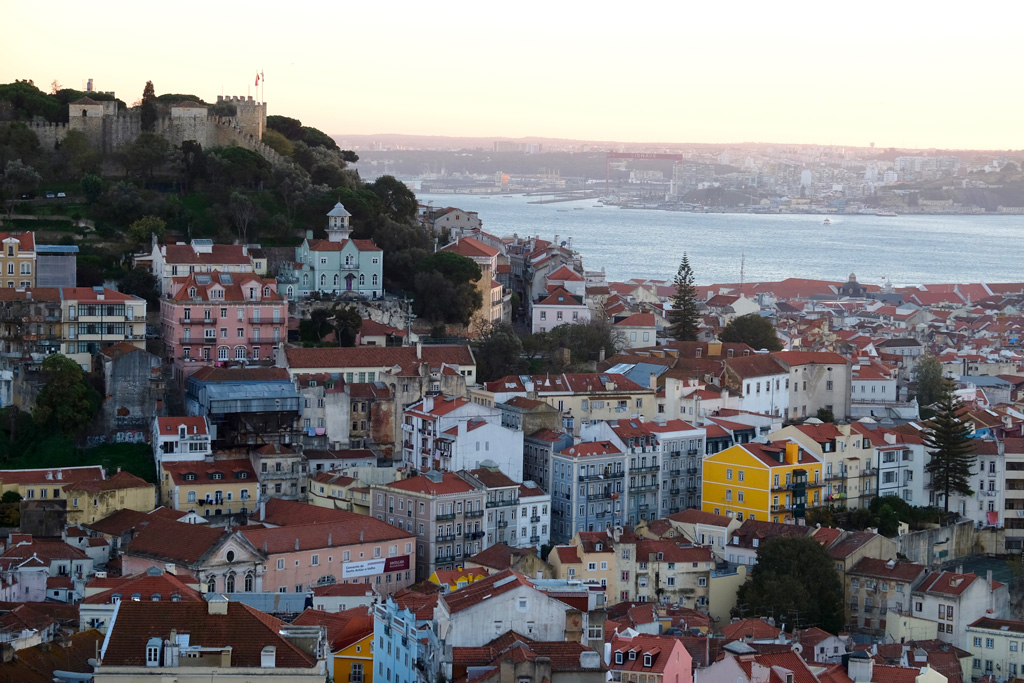
The view from Miradouro do Castelo.
I’d made it up to the grounds outside Miradouro do Castelo just in time. In the distance was what looked like the Golden Gate Bridge, alongside Christ the Redeemer. I did a double take. Though obviously not the actual structures, I later learnt they were inspired by the originals, and they hold a surprising amount of authority in spite of the plagiarism.
All around me small groups of chattering tourists picnicked on the floor or stood looking over the railing in equal awe. Others peered at the panoramic vista through camera viewfinders or at cell phones the end of selfie sticks, and it was one of those magical moments of seemingly universal consensus where everyone within a 20 metre radius was thoroughly satisfied at the life decisions that had lead them to this moment.
Much of Portugal appears to focus on moments like these – the budget-friendly good life that needn’t cost more than a bit of physical exertion, a backpack of snacks, and maybe a glass or two of wine.
Cost-effective accommodation in Lisbon
Though Portugal’s economy may be faring better than her only neighbour, the country still represents good value for foreign travellers. The same is true for the capital, which thrives on a regular flow of tourists to keep its bars, restaurants and iconic sights afloat.
Time your trip to Lisbon well, and you’ll be even more impressed with the setup in the city. In spring (February) or autumn (October), crowds thin, the heat eases off, and prices drop. At this time of year you can pick up a decent hotel room for €80 (R1,168) a night, but it’s really AirBnb and hostels that rule the overnight scene here.
Private rooms in AirBnb apartments abound – you can pick one up in the centre for under €30; entire homes and apartments go for about double that. The hostel scene in the capital is so competitive you can stay in a hotel-quality hostel room for a third of the cost, even less if you’re willing to stay in a dorm and share a bathroom.
Affordable places to eat in Lisbon
Given the receptionist’s perfect suggestion for an afternoon walk, I decided to test his patience with what must be the most annoying guest question of all – where to find a cheap but good meal.
“The Time Out Market,” he said without hesitation, reaching for his pink highlighter once again and gesturing for my map. I grimaced at the thought of a branded market, but listened on.
In 2014, travel publication Time Out hung their name on the outer façade of the historic market hall and turned its insides into a food emporium that now sees something like two million visitors walk through its doors each year. Though on first appearances it looks like a slick cafeteria complete with long rows of tables, too many trash cans, punctuated by clattering cutlery and loud chattering, it’s actually a pretty good find. There are more than 20 restaurants represented in the hall, and most serve up fine food and drink at acceptable prices. For the solo traveller looking to pick up a quality bite to eat from popular local establishments without feeling too spare and alone, this is the place to go.
And so it was that much to my own chagrin I found myself walking through the doors of the market hall more than once. In fact, I had most dinners there, and justified it as an opportunity to sample dishes from a range of restaurants rather than commit to one, and usually for less than €10 (R146) a plate. Lazy and predictable, sure, but sometimes that’s all the weary solo traveller needs.
The tram to Belém
The next afternoon I hopped aboard a tram to the city’s Belém district. A one-way ticket costs just €2.85 (R41) if you buy it on board, and is even more cost effective if you purchase a prepaid card or opt for an unlimited 24 hour travel pass.
The tram journey to Belém is a scenic 25 minutes long, and you should board ready to stand for the full journey – even in the shoulder season you’ll be lucky to get a seat. But when you step out into the waterside touristic paradise of Belém you’ll quickly forgot about the cramped, sticky public transport ride.
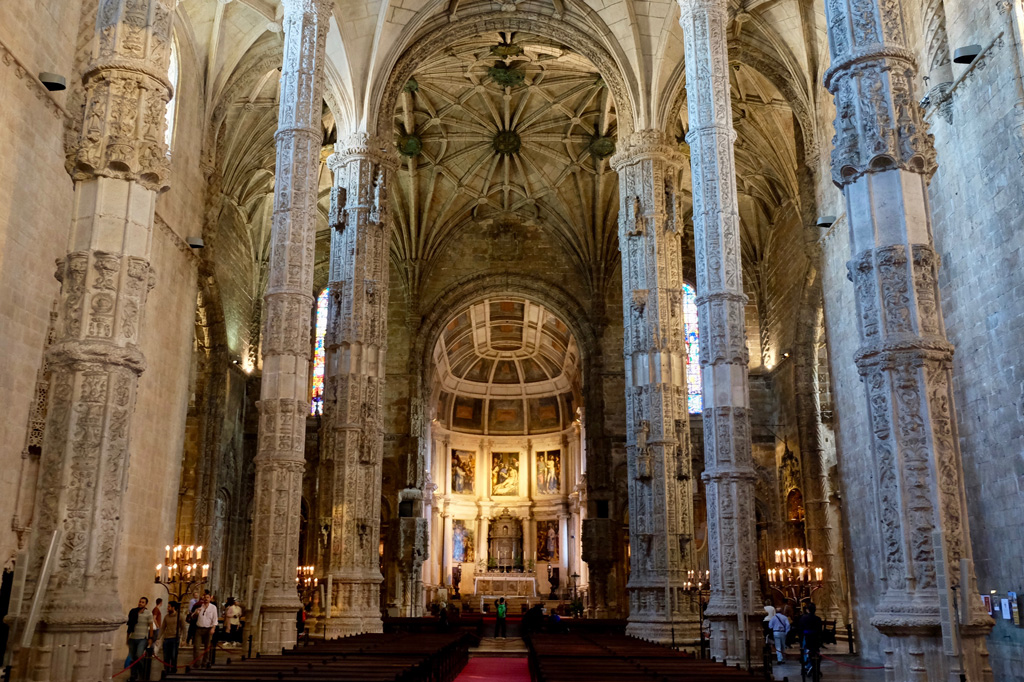
Inside Igreja Santa Maria de Belém.
That is, until you commit to Belém’s big gimmick – queuing up with hundreds of tourists who also heard that they simply had to buy a Pastel de Nata from the famous Pastéis de Belem pastry shop. Like macaroons in Paris, or sausages in Germany, you have to be really unlucky, or a fairly profound food snob, to truly tell the difference between the most celebrated (read well-marketed and overpriced) versions and those you’ll find in most other locations.
Still, I felt an obligation to put their Portuguese pastry to the test – they’ve managed to stay in business since 1837, which should count for something. I picked up more of the bite-size pastries than I needed, found a bench in the beautiful Jardim de Belém opposite, and once again felt a wave of Portuguese positivity wash over me.
There’s a lot more to do in Belém than eat pastries, though – there’s also a good and cheap sandwich shop there called Pão Pão Queijo Queijo. But most people don’t take the shoulder jousting tram ride solely to consume food in a park, so I had a look inside the extravagant Mosteiro dos Jeronimos, and then took a casual walk along the river front to see the next big attraction – the Tower of Belém.
Though both are impressive from the outside, you can pick up a combined ticket to see their inner workings for just €12 (R175), which seems like a bargain given the gravity and beauty of the two structures. Time it exceptionally well (as in, on the first Sunday of the month) and you’ll get in for free.
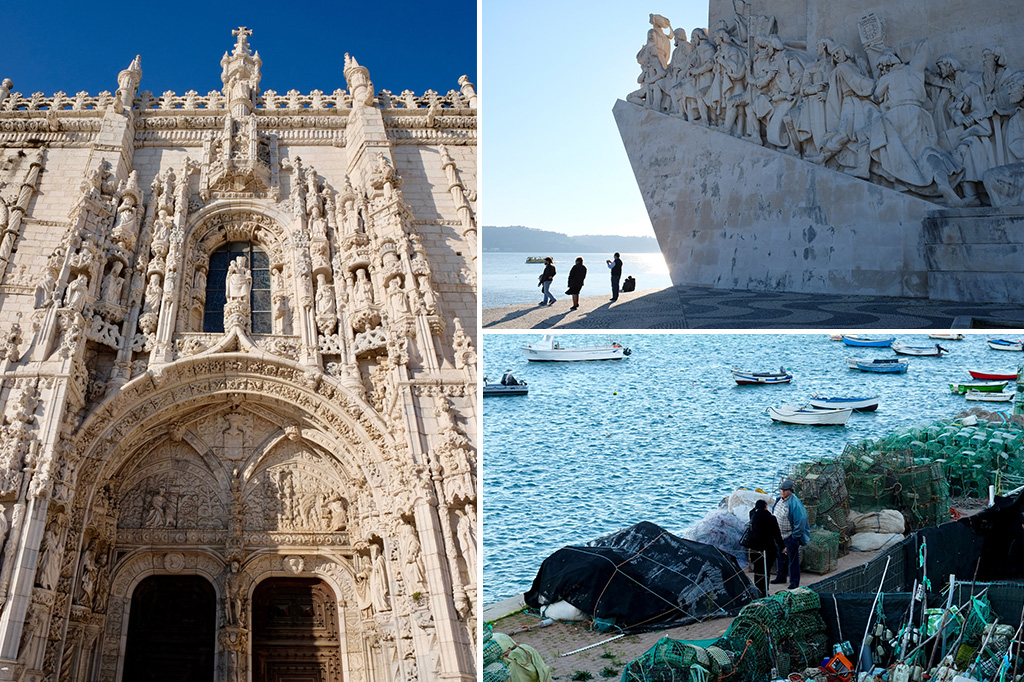
Jerónimos Monastery; Padrão dos Descobrimentos; and the fishing village of Cascais
The train to Cascais
I caught another good view of the bridge and the statue of Christ from the night before from the edge of the river, and then continued west by train. There are several quaint towns and beaches to dip in and out of as you travel due west from the capital, but the train terminated in the fishing village of Cascais, so I set that as my target.
Aside from a life-size John Lennon statue perched on a bench, who I learnt with a start was actually alive and mimed famous Beatles tracks whenever a willing tourist dropped some coins into his hat (and there were plenty), a quaint harbour laden with fishing nets, and a largely unoccupied temporary theme park seemingly left over from the peak season, there wasn’t much more to do in Cascais than sit on the steps above the water and watch the sun slowly slip into the Atlantic.
When darkness fell over the small village shortly after, and an icy breeze whipped in across the waters, I stood up silently, ambled to the station and caught a train all the way back to the centre of Lisbon, completing a day that cost just a handful of Euros.
The best of Lisbon’s nightlife
Later that evening, in the interests of research, I slipped on jeans and a creased shirt and ventured into the night. It is, after all, seemingly impossible to speak to anyone who’s been to Lisbon and not hear endless tales about epic nights on the town, regardless of age or propensity to party.
Rua Nova do Carvalho offers the best and worst of the city’s nightlife. In its early days it served as an alcoholic and sexual refreshment station for weary sailors arriving at the nearby port. So to reflect on the glory days of the district I had a few beers in one-time brothel, now hip and happening bar, Pensão Amor.
Slightly higher up, in both stature and geographically, is one of the best bar-based views of the city at aptly named Park. It’s situated on the top level of an otherwise bland, multi-level urine-stained parking garage and is suitably difficult to find but worth all the effort. On the top floor you can mingle with well-heeled hipsters as you watch the sun set, or, in my case, the city lights twinkling, all set to relaxing tunes spun by the painfully hip DJ inside.
Lisbon’s Bairro Alto is still one of the city’s social focal points. This relaxed, youthful heart of the city bustles from first dark, but no-nonsense owners start sweeping lingering crowds out around 2am. At this point, those determined to make it to sunrise disperse to find a club willing to accept them in their sorry state, of which there are always many, while the rest of us trundled down the hill back home.
Of course, if you’re looking for an altogether more sombre and traditional nightlife affair, there are several Fado bars at which to let it all hang out. Emotionally, that is. This traditional form of music may have lost favour with the younger generation, but it’s as popular as ever with Euro laden tourists who go with the aim of getting a glimpse of Portuguese culture. Not me, though. I opted for what I deemed an altogether more cost-effective and authentic modern day Lisbon experience – sipping a beer out of a plastic cup while sitting on a sticky windowsill in some dive bar I’d struggle to find again, not that I’d ever really want to, until the owner told me it was time to keep moving.
Exploring Lisbon on foot, for free
The next day I tagged along on a free walking tour in an attempt to shake off the hangover and put some context to my until-then aimless rambling through the streets. There are several companies offering free walking tours in various parts of the city, and they’ll only cost you as much as you think they’re worth.
A passionate and informative guide walked me and a handful of other bleary-eyed tourists through the fascinating Alfama. It’s the city’s oldest district, and is packed full of winding alleyways and suitably intriguing charm – passers-by shouting up to second floor windows, elderly women leaning over balconies eyeing out the passing parade, ownerless dogs navigating cobble-stoned streets, and small groups of school boys eagerly swarming around footballs in the small open squares. Considering the guide showed us all this, some of the city’s best views, and spun them together with polite anecdotes for just the fiver I had in my pocket, I considered it an afternoon exceptionally well spent.
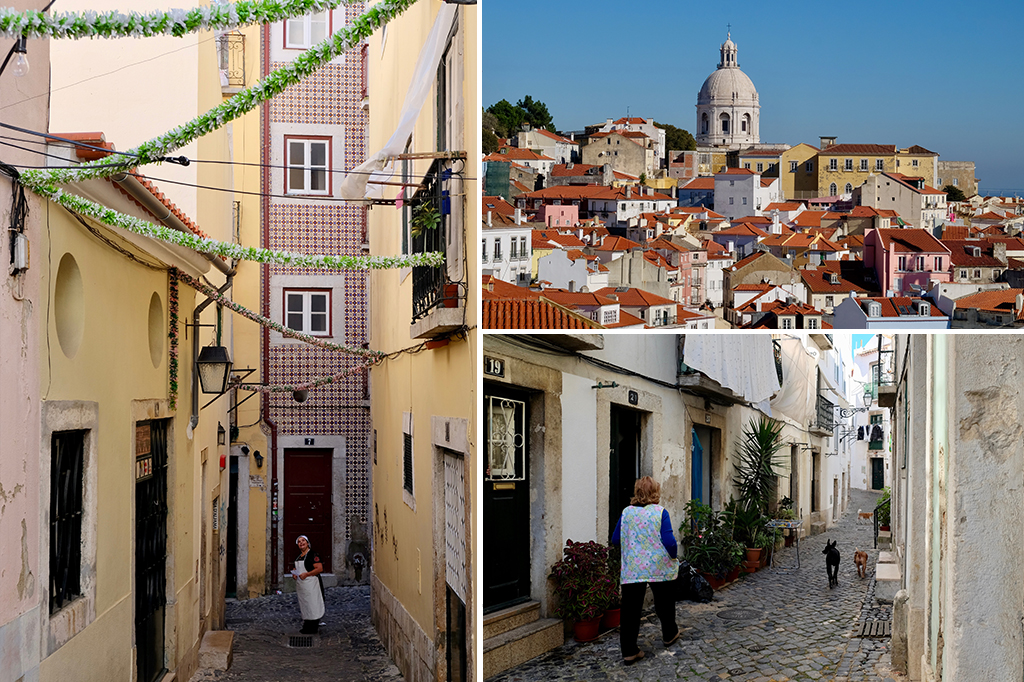
Walking through Lisbon’s Alfama district
Day trips from Lisbon
When you consider just how much there is to soak up in Lisbon and its immediate surrounds, and how vicious its hangouts are rumoured to be, it’s alarming how many day trips there are that also garner rave reviews. On the insistence of another receptionist I spent my last day in Lisbon outside of the capital – in the otherworldly playground that is Sintra.
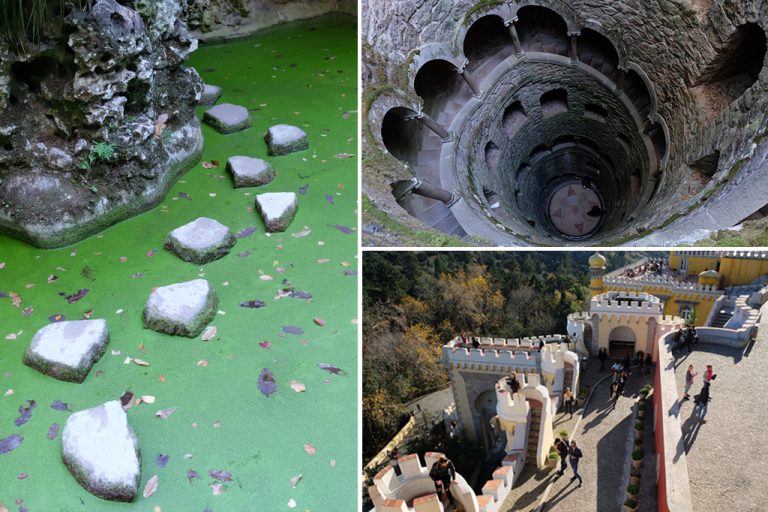
The fairytale land of Sintra.
Sintra is a nearby municipality famed for castles, ruins, mansions, museums, manicured gardens and all-inclusive circular bus routes. It’s by far the most popular day trip from Lisbon and runs very close to my definition of a tourist trap, but the sheer mythical beauty of the place is enough to justify most of the exorbitant entrance fees.
“Don’t aim to do everything,” said Renate, the helpful Portuguese receptionist by daytime generous in-house bartender at night. “You’ll never cope.” She struck me as someone who could always cope, so in spite of the free beers she was supplying me with at the time I’d listened intently as she pulled out a blank sheet of paper and outlined the must-see highlights and how to navigate between them.
There are regular trains from Lisbon to Sintra that cost just over €4 (R58) for a 40-minute each way round trip. Once there, you can pick up a round-trip ticket for the tourist bus that will get you to most attractions in hop-on, hop-off style for €5 (R73).
The first stop Renate had written on my list was Quinta da Regaleira – a stunning 20th century residence and garden that feels like it may well have been designed by Lewis Caroll. In the garden I followed precarious stepping-stones across an algae covered pond, which lead me deep into a network of dark tunnels illuminated only by distant sunlight or the occasional string of fairy lights. Just as I thought I’d walked too far into a never ending network of dark tunnels, I stumbled into a circular patch of sunlight at the bottom of an inverted tower that reached all the way back up to the surface via a spiral staircase.
I could have spent the better half of the day living out the plot of an 1800s fantasy novel in those gardens and summer houses. Time was of the essence, though, and Renate had instructed me that the golden rule to Sintra is to keep moving, and to always take the bus.
So, tempted as I was to trek to the next attraction, I hopped on the Sintra Tourist Bus. It whisked me up a steep switchback road all the way to Pena Palace. This multi-coloured structure sits high on the hills of Sintra, and would be worth the €11 (R160) entrance fee for the views of Sintra, Lisbon and its picturesque surrounds alone. But for that price you also get to explore the vast grounds, castle and walk select hallways of this one-time home of King Ferdinand II.
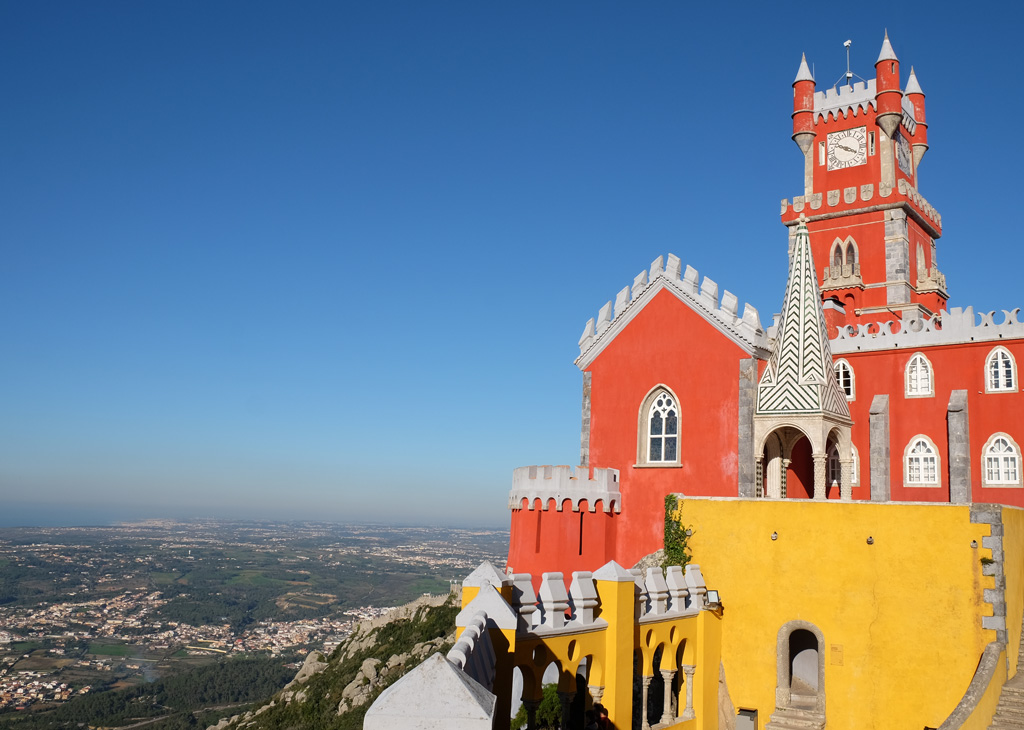
Sintra’s Pena Palace
Even though I’d taken all the advice and limited my visits to just the two attractions, I quickly ran out of time in Sintra and had to beat a hasty retreat back to Lisbon on the evening train.
I found Renate pulling pints and preparing for another night of typical Lisbonian partying at the downstairs bar. In spite of my weary legs, and the fact that I was boarding a budget flight to Rome early the next morning, she insisted I tell her just how right she was about Sintra. So in a decision I was to regret at 6am the next morning, I pulled up a bar stool, accepted the first of several beers slid across the counter in a plastic cup, and reflected nostalgically on my stay in one of Europe’s most captivating capitals.








